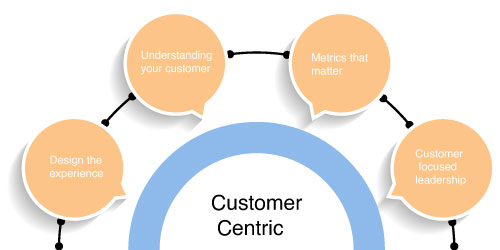Today, owing to a customer-centric business is more important than any other strategy. The game of customer feedback has changed everything, and it has the power to portray any business as good or bad, basically showing how well your business treats its customers. A business can save itself from a negative customer experience as customers can expose business through review sites, screenshots, live streaming, social media, and mobile video. It’s not the only reason business needs to be better, but it becomes a driving business to enhance. Sadly for a business, it’s the bad experiences that are the most publicized. Therefore, you need to have a
customer-centric business to grow and distinguish yourself from your companion. Now, you must be wondering what it means to be customer-centric and what makes it critical for you.
What does customer-centric mean?

Customer-centric business means prioritizing the customer’s experience at each stage of their purchasing journey—before, during, and after the purchase. Here it is more than just delivering good customer service. When you encourage a customer-centric business, the customer becomes the part of every decision you make, their need becomes your priority, and building strong relationships with them becomes central.
For developing a customer-centric business, it is imperative to start it from the core. You have to put yourself in the customer’s shoes; only then you understand their expectations and concerns. Gratitude plays an important role when you decide you run a customer-centric business as you need to respect everyone’s opinion even though you get negative feedback. We understand that there might be some bad customers, but you can treat those customers with respect and benefit of the doubt without thinking like you gave in to their all needs. But if you behave or react badly towards them, you will lose more than a customer as that customer’s negative feedback hampers your business reputation. And as we said earlier, bad reviews spread quickly than positive word of mouth.
Building a customer-centric business has to evolve from its leaders. It sets the tone throughout the organization. Yes, one can make plans and training, but each action and decision reflects a trend and establishes a pattern.
What are the Benefits of a customer-centric culture?

When it comes to making your business customer-centric, all your efforts, actions, and decisions are more focused on the customer.
Focusing on the customer means that your company will get the rewards and experience a step ahead of your competition.
As consumers enjoy your attentiveness towards their needs, they’re more likely to cling around and remain loyal to your business. It increases your customer retention rate and lessens churn. Thus, staying customer-centric improves your overall customer lifetime value and lowers your customer acquisition costs.
These happy customers are more likely to give you positive reviews (building your business’s reputation).
And most importantly, they’re more likely to connect their friends to your business. Customers’ friends believe these recommendations, so they’re more likely to become your customers—and to continue loyal to your business.
Customer-centric business strategies

Customer-centric businesses are more focused on showing their customers how dedicatedly they are working for them.
These businesses understand that customer retention is even more valuable than customer acquisition.
Here is a collection of customer-centric tactics your business can follow:
- Provide outstanding, personalized customer service.
- Make sure that every decision you make through the eyes of your customers before proceeding.
- Welcome your customers’ needs, concerns, and preferences. Then, consolidate their suggestions within future products and practice developments whenever possible.
- Capture all the data you can on what customers prefer and want, and answer to these insights.
- Measure and concentrate on developing these three key metrics: customer lifetime value, customer retention rate, and net promoter score (NPS).
- Launch a loyalty program with enticing rewards for repeat customers. Consider giving a choice of rewards, so customers feel even more valued.
- Make sure that your loyal customers feel like VIPs.
- First, you’ll have to identify your most loyal customers through CRM software, customer satisfaction surveys (such as NPS surveys), customer lifetime value calculations, or multiple methods.
- Then, present, with exclusive perks, sales, and insider experiences.
- These customers are more likely to buy from you repeatedly and are most effortless to retain, so it makes sense to recognize and focus on them.
- Personalize the coupons you grant to each customer based on their purchasing habits.
- Launch a referral program to reward committed customers for sharing your brand with others and further showing how important they are to your business at each stage.
Zappos: an excellent example of a customer-centric brand
Zappos has contributed years to developing a customer-centric culture.
For instance, they commit to owning specific conversations with customers and concentrate on meeting their requirements as quickly and personally as possible—it’s all about connections. Also, they sometimes overwhelm customers with free shipping upgrades or wonderful gifts.
In everything they do, Zappos understands the value of satisfying and developing relationships with the existing customer and trusts that these happy customers will be their most loyal advocates and market the brand for them.
Key Takeaways
Outstanding customer service is a fundamental part of being customer-centric, but genuine customer-centricity requires much more than that. Customer-centric businesses put customers at the forefront of each decision they make and the actions they take.
It may take some time to build your business as customer-centric, but the rewards are well worth it. Your happy customers are more likely to remain loyal to your business and tell others about you.
















